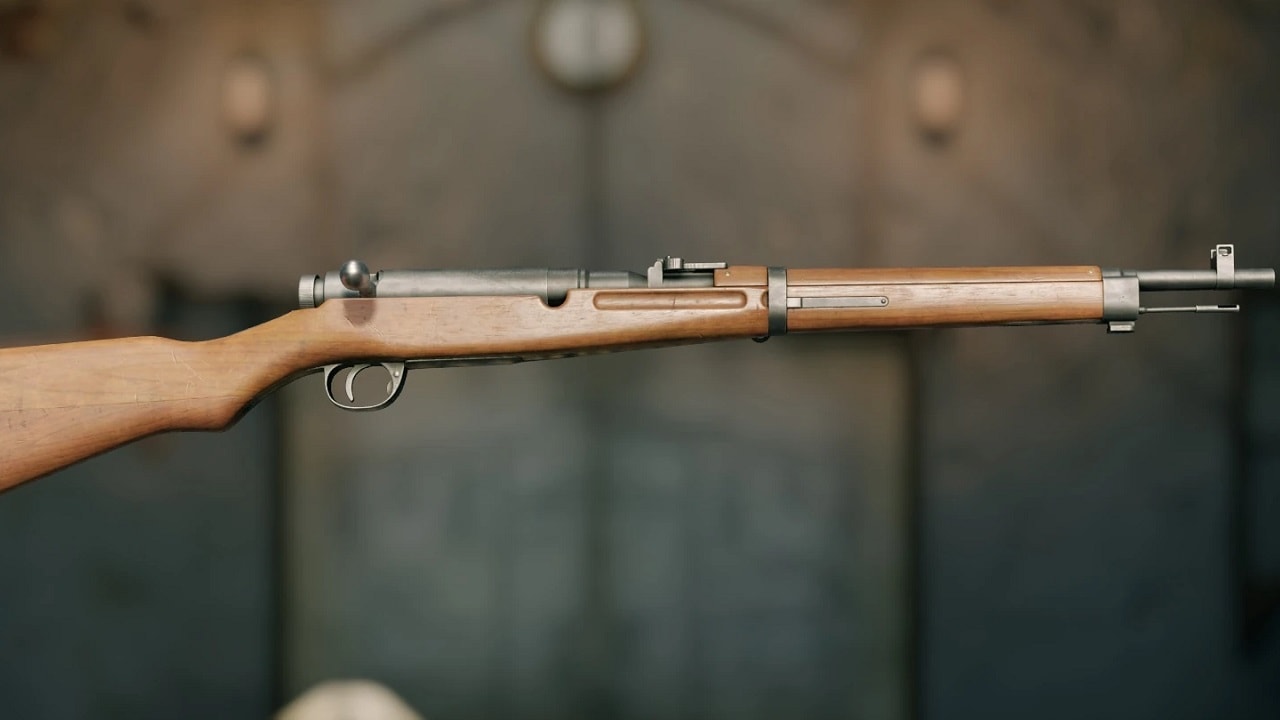During the Second World War, the U.S. became the first nation to adopt a semiautomatic battle rifle as a standard issue weapon for her armed forces, in the guise of the M1 Garand, which General Patton lauded as “the greatest battle implement ever devised.” However, other Allied nations and Axis powers alike were content to stick with bolt-action rifles for the entirety of that conflict: Great Britain with the .303 Lee Enfield; Italy with the Carcano M1891; the Soviet Union with the Mosin-Nagant; Nazi Germany with the Mauser Karabiner 98k (often incorrectly referred to as a K98); and Imperial Japan with the Arisaka. Actually, Japan had two Arisaka rifles in use during WWII, the Type 38 and the better-known Type 99.
Arisaka Type 38 History and Specifications
The Type 38 is the older of the two, developed in 1905 by the eponymous Colonel (陸軍大佐/Rikugun-Taisa) Nariakira Arisaka (1852 – 1915), who would eventually attain the rank of Lieutenant General (陸軍中将/Rikugun-Chūjō). It was chambered for the 6.5x50mmSR Arisaka round, which had a muzzle velocity of 2,500 feet per second and a muzzle energy of 1,966 foot-pounds (2,666 Joules).
In an August 2019 article for Military Factory, author J.R. Potts notes that the Type 38 was highly accurate and very reliable even under the extremely harsh conditions of the jungles of southeast Asia as well as the tropic climes of the Pacific Theatre. However, there were some significant downsides as well:
“The Type 38 rifle was a ‘long gun’ and optimized to use the Type 30 infantry bayonet set at the barrel. In all, the rifle measured 4 feet, 2 inches long and was one of the longest such weapons still in service by the time of the Second World War.
“The additional 20 inches gained by the installed bayonet gave the Japanese soldier a definitive reach against a target when close-quarters fighting ensued. However, the average Japanese infantryman still only stood about 5 feet, 3 inches and thus there would be inherent difficulties when handling such a long weapon. The small stature of the Japanese soldier also required a comparatively small caliber of less powder charge to help contain recoil when the weapon was fired from the shoulder.”
In spite of these shortcomings, over 3.4 million Type 38 rifles were produced, and it was only partially replaced by the next gun on this list when WWII took place. Additional dimensions included a barrel length of 31.4 inches and a weight of 9 pounds 4 ounces.
Arisaka Type 99 History and Specifications
In a December 2014 article for Warfare History Network titled “The Arisaka Rifle: Weapons for the Imperial Japanese Army Way of War,” Jon Diamond states, “It was also noted during the conflict with China that the Type 38 rifle and its 6.5mm ammunition were no longer adequate. Combat experience on the Asian mainland during the 1930s dictated that a higher caliber infantry rifle was needed.”
Hence the advent of the Type 99 in 1938, chambered for the 7.7x58mm Arisaka round, which, using the 182-grain Type 97 “ordinary” cartridge, generated a muzzle velocity of 2,400 fps and a muzzle energy of 2,319 ft-lbs. (3,144 Joules), thus equating to am 18 percent increase in impact energy on the target as well as an 18 percent increase in the size of the hole punched in that target.
In addition, the dimensions of the Type 99 were made more ergonomically friendly to those shorter-statured Japanese troops; an overall length of 3 feet 8 inches, a barrel length of 25.9 inches, and a weight of 8.4 pounds. The tradeoff, of course, was greater recoil, but the Imperial Japanese Army brass deemed that to be a worthwhile sacrifice in light of the gains in stopping power and portability. The newer rifle retained the 5-round capacity of its predecessor as well as the Type 30 bayonet (“juken”) and was every bit as accurate and reliable.
Nonetheless, Japanese soldiers found themselves at a distinct disadvantage when going up against American GIs with those aforementioned M1 Garands that carried the benefits of an 8-round magazine and a significantly higher rate of fire thanks to the semiautomatic function.
Roughly 3.5 million Type 99 Arisaka rifles were produced.
Want Your Own?
According to True Gun Value, “AN ARISAKA TYPE 99 rifle is currently worth an average price of $611.60 new and $576.82 used. The 12-month average price is $575.84 new and $420.42 used,” whilst “AN ARISAKA TYPE 38 rifle is currently worth an average price of $436.33 new and $426.59 used. The 12-month average price is $446.73 new and $431.10 used.” Guns.Com recently sold a Type 38 for $399.99, and that same website currently lists four Type 99s, at $675.99, $700.99, $775.99, and $1,095.99. Meanwhile, Guns International has a full page worth of both rifle types for sale, with the Type 99 starting at $325.00 and the Type 38 starting at $479.99.
Christian D. Orr has 33 years of shooting experience, starting at the tender age of 14. His marksmanship accomplishments include: the Air Force Small Arms Ribbon w/one device (for M16A2 rifle and M9 pistol); Pistol Expert Ratings from U.S. Customs & Border Protection (CBP), Immigration & Customs Enforcement (ICE), and the Federal Law Enforcement Training Center (FLETC) Criminal Investigator Training Program (CITP); multiple medals and trophies via the Glock Sport Shooting Foundation (GSSF) and the Nevada Police & Fires Games (NPAF). Chris has been an NRA Certified Basic Pistol Instructor since 2011.

